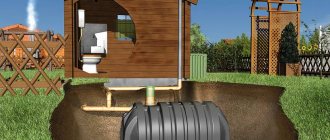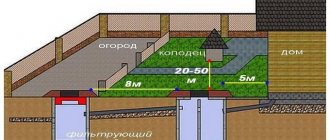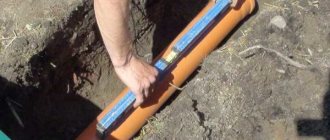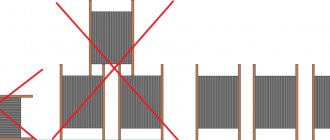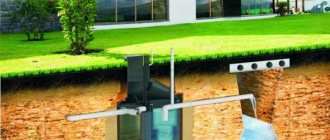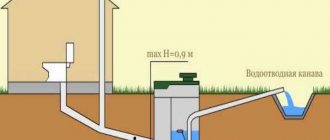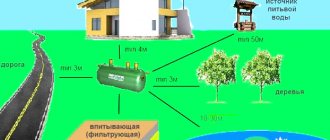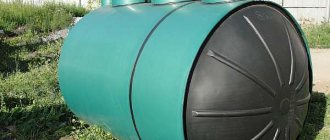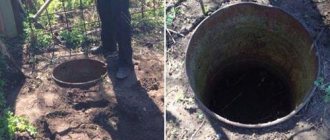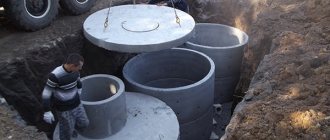Many people know what rules govern the construction of such a necessary structure as a cesspool on a private plot: sanitary norms and rules (SanPiN), as well as building norms and rules (SNiP) that determine what sewerage, water supply networks, water protection, etc. are. , and their requirements must be strictly followed. However, not everyone has information about these requirements. The most important of them are given in our article.
The placement of cesspools is fully regulated by SNIP and SanPiN standards
Permission
Before constructing a cesspool, you must obtain permission. For this purpose, the SES provides:
- Scheme of the location of the object on the site.
- The design of the structure, and it must comply with sanitary standards and regulations.
If documents are submitted that do not comply with the requirements of the law, permission will not be obtained.
But that’s not all, because after construction is completed and even several years later, an inspection inspector may come. In fact, the distance to the cesspool from the well and from other key points must correspond to the submitted documents. Inspectors do not conduct inspections at their own discretion; they often appear on a “tip” from neighbors.
Important! Do not neglect obtaining a permit; it will not cost much. You will have to stand in the corridors of the government agency, but it is cheaper than paying a fine if the distance from the well to the cesspool is incorrect.
It will be possible to obtain permission only if the cesspool is located not on the territory of a neighboring plot, but on your own. Moreover, it does not matter whether this (someone else’s) plot is residential or not and whether it is owned by someone.
Features of drawing up a diagram
In a private house, it is quite possible to equip a drainage pit with your own hands. Brick is often used for this. At the first stage, it is necessary to draw up a plan diagram, which should indicate all the buildings on the site and the distance between them. It is also important to mention the boundaries of the site. You will designate garden paths, water intake wells, gazebos, green spaces and groundwater flow.
Armed with a compass, you will need to install the leg on the plan in the place where the hole is supposed to be laid. The radius of the circle at a scale of 1 to 100 should be 12 cm. If the circle does not touch any buildings on the territory, you can continue to draw a geometric figure with a radius of 20 cm. The focus at this stage should be on how the line to the water intake source went. From this point you need to draw a circle with a radius of 2 cm. Here you should pay attention to the fencing of the area. If the lines of the circles do not cross out the points where the objects are located, then the pit is located correctly.
Types of structures
The placement of a drainage pit in a private house differs in distance standards, depending on the type. The classification is based on the tightness of the structure. Types:
- A simple pit is a pit in the ground into which wastewater is discharged. There is no tightness in the design, so drains can spread in any direction. Here the distances should be maximum from all key points on the site.
- Pit with hard walls. They create less emissions into the soil, which means they are safer. The drainage does not seep through the walls; it goes only into the soil, through the filter bottom - a mixture of sand and crushed stone. Since the wastewater still leaves the cesspool, the distance from the house and from the well is also the maximum according to the standards.
- Sealed pits or plastic containers do not allow sewage to enter the soil at all. The cesspool is cleaned using the pumping method. It is allowed to maintain a minimum distance from the well.
Important! According to SanPiN, any cesspool must be installed only in accordance with the project and after approval by the relevant regulatory authorities.
Other requirements
Pit without bottom
The issues of creating such structures are discussed in more detail in SNiP 2.04.02-84 and 2.04.03-85. Cesspools can be of two types:
- A hole without a bottom.
- Sealed pit.
The first option is suitable for use in households without permanent residence. At the same time, it should not contain wastewater for more than a day. Such structures can be used in summer cottages, where the owners visit only on weekends and with a small group (up to three people).
Construction of a cesspool without a bottom
In structures without a bottom, wastewater seeps into the ground, which is a natural filter. Therefore, there are strict rules governing the distance to the drainage pit from a spring or well (or other open source of water). This indicator will depend on the quality of the soil. For example, it amounts to:
- sandstone and sandstone – at least 50 m;
- loam – 30–35 m;
- clayey soils – 20 m.
Sealed plastic cesspools
Sealed cesspools are more versatile. Such structures can be located on any site, with any number of people living. Sealed containers prevent wastewater from entering the environment, which means they can be located close to residential buildings and a water source. The main thing is that the smell does not interfere with comfortable living. To solve this problem, you can use biological products that contain colonies of bacteria. With their help, sewage will be processed into safe sludge.
When creating hermetically sealed structures, the main requirement is to ensure access for the sewer truck. Since wastewater will not enter the ground, the container will fill quickly. In this case, it is not allowed to overflow over the edges of the pit.
SNiP standards
According to SNiP, a cesspool is an object of increased environmental hazard, therefore its placement must comply with certain standards, namely:
- The distance between the well and the cesspool is 20-50 meters. The same standards apply to the distance from any source of drinking water - a well, a standpipe, or another type of water intake.
- From the foundation of your own house, the neighbor’s, the foundations of other buildings, at least 10-12 meters. If you place the cesspool closer, in the event of a violation of the integrity of the wastewater storage facility, there is a risk of erosion of the foundation and, as a result, destruction of the building.
- The distance from the cesspool to the water supply and its pipes. At least 10 meters; such a distance will prevent sewage from entering the water supply in the event of an accident on the sewer pipeline.
- The depth of the pit should not be more than 3 meters, and only in case of deep groundwater. If they are located high, then only sealed containers or septic tanks can be installed. In both the first and second cases, it is necessary to maintain a distance of 1 meter from the bottom of the pit to the groundwater level. The release of wastewater into the soil is dangerous because it pollutes groundwater, and therefore sources of water intake.
- There should be at least 1.5 meters to the property line (fence), but it is better to do more, then you will be able to avoid troubles with neighbors.
- To the highway, road, if there is one near the site - from 5 meters.
- Distance from a stream, river – from 10 m.
- If there are trees and shrubs on the site, then you need to place cesspools and septic tanks at a distance of 3 meters or more. The decision to move the cesspool into the garden is not the best, because the roots of the plant can simply rot from excess moisture, and besides, not all of them are so moisture-loving.
- It is also impossible to place a cesspool closer to the garden; placement standards are 20-30 meters.
Important! The arrangement of an outdoor toilet also requires compliance with similar standards if a sealed container is not used as a cesspool. A toilet in a country house, although it is not used as often as a sewer system in a private house, it must be placed in accordance with the above standards.
Sump volume
One of the main laws on which most of the norms and requirements of SanPin are based is Federal Law No. 52-FZ (“On the sanitary and epidemiological welfare of the population” of March 30, 1999).
The volumes of cesspools are regulated most strictly by SanPin. The design of the drain tank depends on the average daily amount of waste. Structurally, pits are:
- Open type. They are installed without a bottom, which allows a certain part of the liquid waste to flow into groundwater. This can negatively affect the quality of water in a pond, well or borehole. There is also a negative impact of wastewater on the fertile qualities of the soil;
Rules for arranging an open pit - Closed type or sealed. These pits are safer to use, but they are much more complex to design. If sewage tanks with a closed bottom are installed on the site, then the distance to the facade of a residential building or well can be reduced by several tens of meters. It is more expedient to arrange them in small areas.
Simple closed pit design
SanPiN 42-128-4690-88 specifies sanitary standards to ensure the well-being of the population. They say that if the total volume of wastewater does not exceed 1 cubic meter per day, then the construction of an open pit is permissible. If there is more waste, then a filter or sealed bottom must be equipped. It should be noted that in open pits a complete lack of protection is also not allowed.
SanPin standards describe in sufficient detail the requirements for the protection of groundwater. These requirements are presented in the resolution SP 2.1.5.1059-01 of 2001. Particular attention is paid to the design of the lower part of the waste pit. Sanitary organizations require the installation of a filter bottom, which consists of:
- Sand pillow;
- Crushed stone pillow;
- A stone layer in which building materials of various fractions are used.
It is emphasized that if more than 4 adults live in a house and household appliances connected to the sewer are installed, then a multi-chamber pit or septic tank must be constructed. These are reservoirs with a higher degree of protection against contamination of the environment by waste toxins.
Example of a multi-chamber pit
The rules and regulations for arranging a cesspool in Ukraine are somewhat different from Russian ones. According to Ukrainian legislation, a cesspool can only be made of a closed type from durable, water-resistant material. In any other case, you will not be able to legalize it and are subject to fines, including a court order to remove the tank from the site.
If there are communications on the site
When the location of the site is such that underground communications pass through it, then a certain distance must also be maintained to them. The distance of the cesspool depends on the type of pipes:
- Asbestos-cement or reinforced concrete - from 5 meters.
- Cast iron with a diameter of up to 20 cm - 1.5 m.
- Cast iron with a diameter of more than 20 cm - from 3 m.
- Gas pipes – from 5 meters.
Important! When moving pipes away from the cesspool on a site, you should be guided by the rule, the farther the better.
Punishment for non-compliance
They are punished for violating the rules for the location of cesspools and street toilets with a ruble, that is, they issue a fine. Its size depends on several factors:
- Have any cases of violation of environmental legislation by a citizen been previously recorded?
- How badly the norms have been violated. This means that if the cesspool is closer than necessary to the foundation of the house, the fine will be less than if a potentially dangerous object is located closer than 20 meters from a source of drinking water.
The specific amount of punishment is determined by the court; it is in court that the measure of punishment for such an offense is determined. Violation of environmental standards is dangerous for many people, so fines amount to thousands of rubles.
If there is not enough space
It happens that those responsible for violating sanitary standards make excuses by saying that there is not enough space, and that is why they violated the rules. But in fact, it is possible to install a toilet correctly or arrange a cesspool. If, according to the standards, there is not enough space on the site, the solution is to construct a pit using a sealed container. There are also septic tanks and other installations that can be mounted on the surface, they are also sealed.
Of course, such solutions are more expensive than a cesspool, but by not complying with SNiP standards, the owner of the site primarily harms himself. It pollutes water and makes the soil unsuitable for growing any vegetables, trees, and shrubs.
Compliance with sanitary standards regarding the placement of a cesspool and the location of the toilet according to SNiP in the country is very important. Violation is fraught not only with fines, but also with harm to one’s own health.
